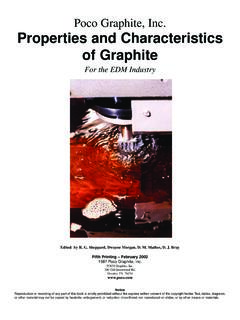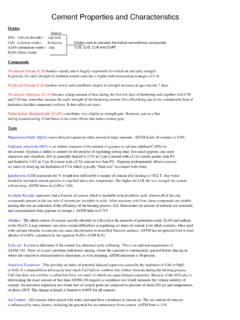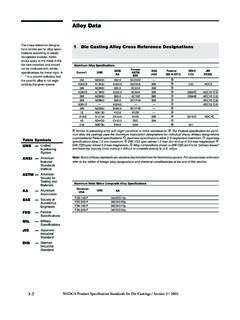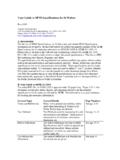Transcription of Roadmap for Megawatt Class Power Switch …
1 Roadmap for Megawatt Class Power Switch Modules utilizing large area silicon carbide MOSFETs and JBS Diodes Jim Richmond Cree, Inc. 4600 silicon Drive Durham, NC 27703, USA Mrinal Das Cree, Inc. 4600 silicon Drive Durham, NC 27703, USA Scott Leslie Powerex, Inc. 200 E. Hillis St. Youngwood PA 15697, USA Anant Agarwal Cree, Inc. 4600 silicon Drive Durham, NC 27703, USA Brett Hull Cree, Inc. 4600 silicon Drive Durham, NC 27703, USA John Palmour Cree, Inc. 4600 silicon Drive Durham, NC 27703, USA Abstract -- Recent dramatic advances in the development of large area silicon carbide (SiC) MOSFETs along with their companion JBS diode technology make it possible to design and fabricate high Power SiC Switch modules.
2 An effort underway by the Air Force Research Laboratory has lead to the development of a SiC dual Switch Power module capable of operating at a junction temperature of 200 C. Two additional efforts are set on achieving the Megawatt goal. An effort by the Army Research Laboratory is focused on modules to be used for traction and Power conversion applications. The highest Power 1200V all-SiC dual Switch Power modules produced is capable of 880 amps. A DARPA effort to develop a solid state Power substation has produced a 10kV/50A SiC dual Switch Power module .
3 Higher current modules in both voltage ratings have been designed. These SiC MOSFET modules represent the next level of integration for SiC Power devices. This is a critical technical milestone in the progression toward highly reliable, high efficiency, Power systems. This technology is relevant in the current energy-conscious environment and will translate to significant energy savings for hybrid and electric vehicles, solar Power and alternative energy system inverters, and industrial motor drives. Index Terms MOSFET Switches, Power Conversion, Power MOSFET, SiC I. INTRODUCTION With increasing global emphasis on energy efficiency, improved Power devices are critical to the development of the next generation of Power systems.
4 Increasing the efficiency of Power conversion systems produces multiple benefits. Increasing the efficiency of a system has the obvious benefit of increasing the Power output of the system, and it also has the benefit of reducing the amount of waste heat being generated, leading directly to a reduction in the size, weight and complexity of the cooling system. Further decreases in size and weight can be achieved by operating the system at a higher frequency, thereby reducing the number and mass of passive components. SiC, a wide bandgap semiconductor material, has an electric-field breakdown capability that is ten times that of silicon and also has excellent thermal conductivity.
5 SiC is also a robust material since it is both physically hard and maintains its properties at extremely high temperatures. When properly designed and fabricated, a Power device based on SiC will result in a device with superior characteristics compared to its silicon counterpart. The device characteristics are low conduction losses, low switching losses, higher voltage operation, high temperature operation and the ability to operate at high current density for short periods (surge). Depending on the device type and the specific design, the device characteristics can be optimized to suit the system requirements.
6 SiC Power devices, when used in a system, will allow the system to operate at higher efficiency. The silicon carbide Power devices available today have been shown to outperform their silicon counterparts [1, 2, 3]. II. large area SIC DEVICES AND module CONSIDERATIONS Recent advances allow the fabrication of large area SiC Power devices. The largest single chip device fabricated in SiC to date is a 180 kV PiN Diode [4]. This device has a die size of cm x cm. The availability of large area SiC chips does not mean they are cost effective for Power module applications. As in silicon , the die cost increases exponentially as the device size is increased due to reduced yield and a decrease in the number of devices that can fit on a wafer.
7 As an example, a 100A silicon chip costs times that of a 50A chip and a 200A chip cost times that of a 100A chip [5]. This is one reason it is common to find multiple die paralleled in a Power module . Another reason to use smaller die is to increase reliability by reducing the thermal stress due to thermal coefficient of expansion (TCE) mismatch between the chip and the substrate. Increasing the number of die in a module also increases the assembly cost and decreases the module yield. Care must be taken not to offset the chip cost savings with increased module assembly cost. Due to the higher material and processing cost associated with SiC Power devices, the cost to die size relationship is more pronounced for SiC.
8 This is the main reason SiC Power modules parallel additional lower current die than what is common in silicon based Power modules. Unlike silicon IGBTs and fast recovery diodes, SiC MOSFETs and SiC JBS diodes are easily paralleled due to their positive coefficient of on-resistance with temperature. Due to this, no matching of device on-state voltage drop is required when paralleling the SiC devices. Industry has invested many years solving the issues associated with paralleling many Power semiconductors in a Power electronic module . The focus with the SiC module is to combine the SiC Power devices with the best module materials and processes to develop best in Class modules.
9 III. HIGH TEMPERATURE module The SiC module shown in Fig. 1 was developed under contract from the Air Force Research Lab (AFRL) to be utilized in inverters that drive the flight control actuators on combat aircraft. The operating environment for this module requires high temperature operation while maintaining low losses. The module is a dual Switch configuration (see DUT section in Fig. 6) with a voltage rating of 1200 volts and a current rating of 100 amps. It is capable of operating at a junction temperature of 200 C which is a 50 C increase over the operating temperature of silicon based Power modules.
10 To decrease development time the module design is based on the Powerex silicon IGBT module CM100DY-24NF. Since the silicon IGBT module also has a rating it provides a convenient benchmark for testing the SiC module . Fig. 1. External view of , all-SiC Half H-Bridge Power module . Two variations of the module were produced. Version A, shown in Fig. 2, uses five x SiC MOSFET die and three 4mm x SiC JBS diode die in parallel for each Switch to achieve the 100 amp current rating. Each SiC MOSFET has a nominal current rating of 25A and the SiC JBS diode has a current rating of 50A. Version B of the module , shown in Fig.








